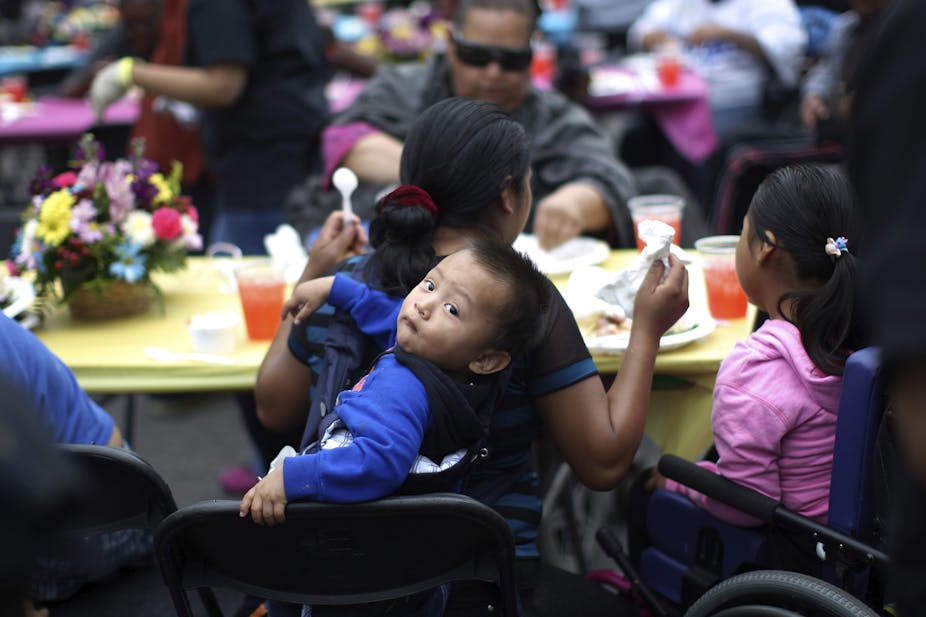Poverty’s grip on America’s black children has proven strong, as they continue to have the highest poverty rates with no relief in sight, according to a recent Pew Research analysis of Census Bureau data.
But there is much more to the story of childhood poverty in America.
In particular, the surprisingly low rate Pew reported for Asian-American children merits a closer look.
The Census Bureau’s one-size-fits all measure of poverty has not kept up with the increased diversity of groups in America experiencing poverty. A more nuanced picture is important because it would enable us to develop more effective policies and programs to address childhood poverty.
Here, we chose to look at Asian Americans, given they are one of the fastest-growing groups and often invisible in discussions on poverty.
Drill down deeper
The numbers released by Pew don’t drill down far enough to tell the complete story about Asian-American poverty.
In their analysis, groups like the Asian-American and Pacific Islander populations are lumped together, or aggregated. Poverty in this group is masked by fairly high median income of US$72,000, compared to the median US adult income of $53,000. That supports the narrative we live with when talking about Asian Americans as the model minority achieving the American Dream. However, if disaggregated, some Asian-American groups have the most rapidly growing poverty rates among all racial and ethnic groups.
Lumped together, poverty statistics make it too easy for policymakers to overlook people like the young Bangladeshi mother, Nazma Begum. Nazma works two jobs, as a cashier at a Subway and cleaning homes, to earn just enough to feed her children and pay for a shared roof over their heads in New York City.
We most often hear about the wealthiest sector of this community: Asian Americans working in Silicon Valley or Wall Street. Lost are those like Hmong and Laotians in Minnesota who have among the highest poverty rates of all ethnic groups in the state.
Look at growth rates
In the wake of the recession and the recovery period from 2007 to 2011, a study by the National Coalition for Asian Pacific American Community Development highlights the growth in poverty rates across racial and ethnic groups.
Looking at growth rates – rather than absolute rates – changes the story significantly. Over a four-year period, Hispanic poverty grew by 42%. The Asian-American/Pacific Islander poverty rate grew by 38%. This study shows lower poverty growth rates for both blacks (20%) and whites (27%).
The most striking difference from this growth study is a 60% increase in poverty for Native Hawaiians and Pacific Islanders.

From 2000 to 2011, the overall Asian-American and Pacific Islander population also grew. Most of these people were not poor. Highly educated and skilled immigrants outnumber the lower skilled Asian refugees that came to the US during that same period. This may be one reason Pew found Asian-American childhood poverty had improved. Another reason may be the extra social and financial buffer multigenerational family structure offers many Asian Americans.
Refine historic measures
The way we measure poverty in the US has changed over time.
In the 1960s, poverty was based on a simple measurement of three times the minimum food budget.
In 2011, the supplemental poverty measure (SPM) was established. The SPM is based on equal expenditures on food, clothing, shelter and utilities. It makes geographic adjustments for housing costs. This new measure also accounts for work-related costs like childcare and makes adjustments for government benefits like Earned Income Tax Credit, energy assistance, housing subsidies and food stamps.
The SPM is an improvement from just looking at food expenses. Using this poverty measure, the Annie E Casey Kids Count highlights differences in childhood poverty and how well the safety net works across the states and District of Columbia.
Kids Count shows us that children experience poverty differently. Influencing factors range from the cost of living and state and federal policies – as well as community safety, their parents’ education and employment history, immigration status, quality of caregiving and access to healthy food and health care.
A 2014 report by the Center for Economic Opportunity revealed that nearly half of New York City’s population is living near poverty – with the largest group being Asian-Americans. New York state’s poverty measure based primarily on the supplemental poverty measure allows for analyzing poverty across demographic groups and neighborhoods.
New ways of measuring
Could we adopt an even better measurement? Perhaps.
Officials in the United Kingdom recently moved the focus away from measuring poverty by family income to examining the root causes of poverty. The UK is looking at factors including education, unemployment, debt and addiction to target meaningful changes in the life chances for children throughout the country.
The United States could go even one step further and take a page from UNICEF. That would involve expanding our understanding of childhood poverty beyond consumption, income and material deprivation to also include well-being.
Representatives Danny Davis, D-Ill, Gerald Connolly, D-Va, Barbara Lee, D-Calif and Elijah Cummings, D-Md may be leading the way to do just that by introducing the “Child Poverty Reduction Act of 2015.”
Better poverty measures help us to go beyond understanding who is poor to assessing ways to move children and families toward greater economic success. This includes supportive services, housing and asset building.
Expanded measures of poverty will help us understand the factors that lead to poverty. They will move us closer to measuring access to opportunities. This will ensure those most vulnerable in our society are accounted for as we continue to embrace economic recovery for everyone.
Seema Agnani, director of policy with the National Coalition for Asian Pacific Americans Community Development, contributed to this article. She has 20 years of experience in implementing anti-poverty programs in the area of housing, and economic development and is a Public Voices Greenhouse participant for Global Policy Solutions.

